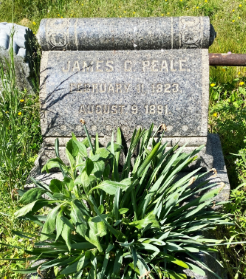Title: City councilmember, vinegar manufacturer
Birthdate: February 11, 1823
Death Date: August 9, 1891
Plot Location: Circle of St. John, Lot 4, Division F

The Peale family included several well-known artists from the post-Revolutionary War era. George Washington sat for seven portraits by Charles Wilson Peale, who painted many of the founding 
 fathers. His son, Rembrandt Peale, was a prolific portrait painter who became famous for these iconic images of Thomas Jefferson and George Washington.
fathers. His son, Rembrandt Peale, was a prolific portrait painter who became famous for these iconic images of Thomas Jefferson and George Washington.
The artistic talent skipped a generation with James Claypoole Peale, Rembrandt’s cousin. His career was in banking, but his son, James Godman Peale, did take up a brush from time to time. One of his paintings even went to auction as recently as 2008.
But the smell of paint didn’t appeal to him as much as the smell of vinegar. James took up the manufacture and sale of an essential and in-demand product in a port city like Philadelphia. Vinegar was popular in food preparation and preservation, in folk medicine, and as a solvent in cleaning.
 James claimed in this 1857 advertisement that his product was free from acid, but if it had no acetic acid it wouldn’t be vinegar. He was one of 11 vinegar manufacturers in the 1861 city directory. At this point he was nearly 40 years old.
James claimed in this 1857 advertisement that his product was free from acid, but if it had no acetic acid it wouldn’t be vinegar. He was one of 11 vinegar manufacturers in the 1861 city directory. At this point he was nearly 40 years old.
All that is known of his previous occupations was that he was listed as a clerk in the 1850 census. He married a woman with the curious name of Ellen Q.M. Fields in 1845 and had three boys: Washington (1847-1901), Fulton (1848-1896), and Clifton (1857-1939). The oldest grew up to be a stock broker, and the other two were plumbers. James’ vinegar business was close to the river, on 3rd Street, and the family residence was on Wharton and then on 5th for over 30 years.
James also took up an interest in local politics as a young man. He served on the city’s Common Council from the First Ward for 12 years and as a member of the Board of Health for eight years.
In his sixties, James apparently left the vinegar business, spending his last years as an accountant  at his son’s brokerage firm. Chronic kidney disease took its toll, ultimately taking his life in 1891.
at his son’s brokerage firm. Chronic kidney disease took its toll, ultimately taking his life in 1891.
His will reflected his good business sense that he probably learned from his father, the banker. He designated portions of his estate to be put in trust for his sons and used to generate interest, wiith quarterly payments of $250 to be made to his wife for the rest of her life.
Fulton married but had no children, and died of a brain tumor in 1896. Washington and his wife had two children, but he died from a blockage of gallstones in 1901. Neither of them were buried at Mount Moriah but Ellen was, after losing her life to breast cancer the following year.
Since there was only one son still alive, she left much of the estate in trust for Washington’s two children and Clifton’s one child. Clifton and his wife died within two months of each other in 1939. Both were buried on the Yeadon side of Mount Moriah in Section 104.
 The Peale plot originally had a border of iron pipe, part of which remains. The “cradle graves,” shown here, include the words “Father” and “Mother” at the foot. Flowers have been planted in recent years in the raised beds, thanks to volunteers who care for these and other cradle graves at Mount Moriah.
The Peale plot originally had a border of iron pipe, part of which remains. The “cradle graves,” shown here, include the words “Father” and “Mother” at the foot. Flowers have been planted in recent years in the raised beds, thanks to volunteers who care for these and other cradle graves at Mount Moriah.

Support the Friends of Mount Moriah
Help us in our mission to restore and maintain the beautiful Mount Moriah Cemetery by donating to our cause or volunteering at one of our clean-up events.

